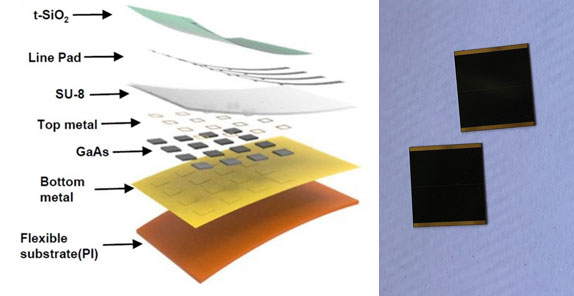Compared with rigid solar cells, flexible thin film solar cells have a wide range of substrate materials (such as metal, glass, plastic, etc.), light weight, bendable, good surface coverage and other advantages. They have a wide application prospect in aerospace and military fields. Therefore, flexible thin-film solar cell has become the top priority in the development of solar cell technology in the future. It is a new flexible thin-film solar cell suitable for aerospace, military and civil. Through theoretical calculation and design simulation, the flexible thin-film solar cell model is established, and the high-efficiency lattice mismatch triple junction GaAs epitaxial layer is used as the functional area of solar cell, Using flexible thin film metal or organic as solar cell substrate, the epitaxial layer and flexible substrate are combined by bonding technology. Through the research of this subject, the simulation design and anti irradiation design of each functional layer of GaAs solar cell are completed, and a number of processes such as lattice mismatch epitaxial growth, bonding, lithography, evaporation antireflection film and dicing are broken through. Finally, a flexible thin-film GaAs solar cell with photoelectric conversion efficiency of 27.08% (25 C, AM0) is prepared.

Ultra-Lightweight Flexible InGaP/GaAs Tandem Solar Cells with a Dual-Function Encapsulation Layer,Conventional solar cells are generally two layers of glass, with EVA material and cell structure in the middle. Such components are heavy, require supports during installation, and are not easy to move. The flexible thin-film solar cell does not need glass back plate and cover plate, and its weight is 80% lighter than that of double-layer glass solar cell module. The flexible cell with PVC back plate and ETFE thin-film cover plate can even be bent arbitrarily, which is convenient to carry.
Dye sensitized solar cells and organic perovskite solar cells combined with nanotechnology have obvious advantages in material and device assembly. They are the mainstream flexible solar cells in the world.